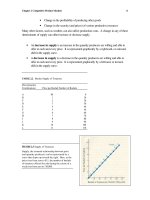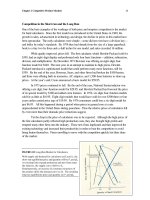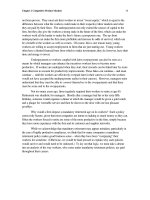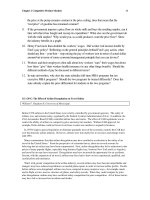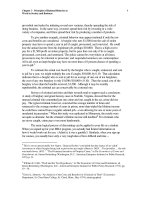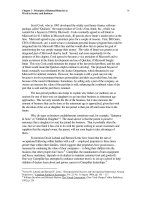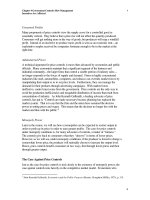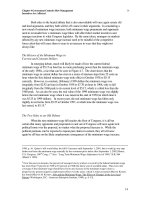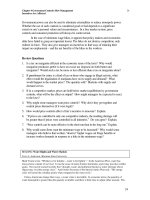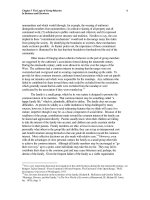Tài liệu Microeconomics for MBAs 26 pdf
Bạn đang xem bản rút gọn của tài liệu. Xem và tải ngay bản đầy đủ của tài liệu tại đây (72.2 KB, 10 trang )
Chapter 7 Market Failures: External Costs
And Benefits
20
monopoly on the product by raising the price after the buyer commits to it at the attrac-
tive initial price. The seller may promise not to raise the price, but the buyer will be
taking an expensive risk to trust the honesty of the promise. A long-term contract is
possible, but it is difficult to specify all the contingencies under which a price increase (or
decrease) would be justified. Also, such a contract can reduce the flexibility of the buyer
as well as the seller, and legal action to enforce the contract is expensive.
Another possibility is for the seller to give up his or her monopoly position by
licensing another firm to sell the product. By doing so the seller makes his or her
promise to charge a reasonable price in the future credible, since if the seller breaks the
promise the buyer can turn to an alternative seller. Giving up a monopoly position is a
costly move of course, but it is exactly what semiconductor firms that have developed
patented chips have done. To make credible their promise of a reliable and competitively
priced supply of a new proprietary chip (the use of which requires costly commitments by
the user), semiconductor firms have licensed such chips to competitive firms. Such a
licensing arrangement is another example of making profits by way of a hostage intended
to encourage honesty.
7
The more difficult it is for consumers to determine the quality of a product or
service, the more advantage there is in committing to honesty with hostage arrangements.
Consider the case of repair work. When someone purchases repair work on their car, for
example, they can generally tell if the work eliminates the problem. The car is running
again, the rattle is gone, the front wheels now turn in the same direction as the steering
wheel, etc. But few people know if the repair shop charged them for only the repairs
necessary, or if it charged them for lots of parts and hours of labor when tightening a
screw was all that was done. One way repair shops can reduce the payoff to dishonest
repair charges is through joint ownership with the dealership selling the cars being
repaired. In this way the owner of the dealership makes future car sales a hostage to
honest repair work. Dealerships depend on repeat sales from satisfied customers, and an
important factor in how satisfied people are with their cars is the cost of upkeep and re-
pairs. The gains a dealership could realize from overcharging for repair work would be
quickly offset by reductions in both repair business and car sales.
Automobiles are not the only products in which it is common to find repairs and
sales tied together in ways that provide incentives for honest dealing. Many products
come with guarantees entitling the buyer to repairs and replacement of defective parts for
a specified period of time. These guarantees also serve as hostages against poor quality
and high repair costs. Of course, guarantees not only provide assurance of quality, they
provide protection against the failure of that assurance. Sellers often offer extra assur-
ance, and the opportunity to reduce their risk, by selling a warranty with their product
that extends the time, and often the coverage, of the standard guarantee.
7
When Intel developed its 286 microprocessor in the late 1970s, it gave up its monopoly by licensing other
firms to produce it [as discussed by Adam M. Brandenburger and Barry J. Nalebuff, Co-opetition (New
York: Currency/Doubleday, 1996), pp. 105-106].
Chapter 7 Market Failures: External Costs
And Benefits
21
Moral Hazard and Adverse Selection
While guarantees and warranties reduce the incentive of sellers to act dishonestly,
they create opportunities for buyers to benefit from less than totally honest behavior.
These opportunities are present to one degree or another in all forms of insurance and
come as two separate problems, one known as moral hazard (or the tendency of
behavior to change after contracts are signed, resulting in unfavorable outcomes from the
use of a good or service) and the other known as adverse selection (or the tendency of
people to buy good or service when they know their characteristics are undesirable to
sellers). Consider first the problem of moral hazard.
Knowing that a product is under guarantee or warranty can tempt buyers to use
the product improperly and carelessly, and then blame the seller for the consequences.
With this moral hazard in mind, sellers put restrictions on guarantees and warranties that
leave buyers responsible for problems they are in the best position to prevent. For exam-
ple, refrigerator manufacturers ensure against defects in the motor but not against damage
to the shelves or finish. Similarly, automobile manufacturers ensure against problems in
the engine and drive train (if the car has been properly serviced) but not against damage
to the body and the seat covers. While such restrictions obviously serve the interests of
sellers, they also serve the interests of buyers. When a buyer takes advantage of a
guarantee by misrepresenting the cause of a difficulty with a product, all consumers pay
because of higher costs to the seller. Buyers are in a prisoners’ dilemma in which they
are better off collectively using the product with care and not exploiting a guarantee for
problems they could have avoided. But without restrictions on the guarantee each indi-
vidual is tempted to shift the cost of their careless behavior to others.
Adverse selection is a problem associated with distortions arising from the fact
that buyers and sellers often have different information that is relevant to a transaction.
Most of this chapter has been concerned with the ways sellers commit themselves to
honestly revealing the quality of products when they have more information about that
quality than do buyers. But in the case of warranties it is the buyer who has crucial
information that is difficult for the seller to obtain. Some buyers are harder on the prod-
uct than average and others are easier on the product than average. The use of automo-
biles is the most obvious example. Some people drive in ways that greatly increase the
probability that their cars will need expensive repair work, while others drive in ways that
reduce that probability. If a car manufacturer offers a warranty at a price equal to the
average cost of repairs, only those who know that their driving causes greater than
average repair costs will purchase the warranty, which is therefore being sold at a loss. If
the car manufacturer attempts to increase the price of the warranty to cover the higher
than expected repair costs, then more people will drop out of the market leaving only the
worst drivers buying the warranty.
8
Even though people would like to be able to reduce their risks by purchasing war-
ranties at prices that accurately reflect their expected repair bills, the market for these
8
This warranty problem is similar to the lemon problem discussed earlier in this chapter, but in this case it
is the buyers who are supplying the lemons in the form of their behavior.
Chapter 7 Market Failures: External Costs
And Benefits
22
warranties can obviously collapse unless sellers can somehow obtain information on the
driving behavior of different drivers. If all buyers were honest in revealing this
information they would be better off collectively. But because individual buyers have a
strong motivation to claim they are easier on their cars than they actually are, sellers of
warranties try to find indirect ways of securing honest information on the driving
behavior of customers. For example, warranties on “muscle” cars that appeal to young
males are either more expensive, or provide less coverage, than warranties on station
wagons.
This section has focused primarily on business arrangements that motivate firms
to deal honestly with customers, and our discussion of these arrangements is far from
exhaustive. Honesty is also important in the interaction between shareholders and
managers, employers and workers, and creditors and debtors, and many different types of
arrangements exist that motivate trustworthy behavior in these relationships. Such
business arrangements serve a variety of purposes such as marketing products, financing
capital investment, and securing productive workers, but understanding any of them
requires recognizing the importance business people attach to being able to commit
themselves credibly to honesty in their dealings with others.
Concluding Comments
As we have argued, a market economy will overproduce goods and services that impose
external costs on society. It will underproduce goods and services that confer external
benefits. Sometimes, but not always, government intervention can be justified to correct
for externalities. To be worthwhile, the benefits of action must outweigh the costs.
Some ways of dealing with external costs and benefits are more efficient than
others. Even when government intervention in the market is clearly warranted, the
method of intervening must be carefully selected.
Some critics of markets suggest that markets are bound to fail because of the
gains to business from being dishonest, which implies a form of “externality.” While we
would be the first to recognize the pervasiveness of dishonest behavior, we also hasten to
stress that markets have built-in incentives for people to be more honest that they might
otherwise be.
Review Questions
1. The existence of external costs is not in itself a sufficient reason for government
intervention in the production of steel. Why not?
2. “Population growth will lead to increased government control over people’s
behavior.” Do you agree or disagree? Explain.
4. Developers frequently buy land and hold it on speculation; in effect they “bank” land.
Should firms be permitted to buy and bank pollution rights in the same say? Would
such a practice contribute to overall economic efficiency?
Chapter 7 Market Failures: External Costs
And Benefits
23
5. “If allowing firms to trade pollution rights lowers the cost of meeting pollution
standards, it should also allow government to tighten standards without increasing
costs.” Do you agree or disagree? Why?
6. If businesses are permitted to sell pollution rights, should brokers in pollution rights
be expected to emerge? Why or why not? Would such agents increase the efficiency
with which pollution is cleaned up?
7. If pollution rights are traded, should the government impose a price ceiling on them?
Would such a system contribute to the efficient allocation of resources?
8. If you were a producer, which method of pollution control would you favor, the
setting of government standards or the auction of pollution rights by government?
Why?
CHAPTER 8
Consumer Choice and Demand in
Traditional and Network Markets
It is not the province of economics to determine the value of life in “hedonic units” or
any other units, but to work out, on the basis of the general principles of conduct and the
fundamental facts of social situation, the laws which determine prices of commodities
and the direction of the social economic process. It is therefore not quantities, not even
intensities, of satisfaction with which we are concerned. . . .or any other absolute
magnitude whatever, but the purely relative judgment of comparative significance of
alternatives open to choice.
Frank Knight
eople adjust to changes in some economic conditions with a reasonable degree of
predictability. When department stores announce lower prices, customers will pour
through the doors. The lower the prices go, the larger the crowd will be. When the
price of gasoline goes up, drivers will make fewer and shorter trips. If the price stays up,
drivers will buy smaller, more economical cars. Even the Defense Department will
reduce its planned purchases when prices rise.
Behavior that is not measured in dollars and cents is also predictable in some
respects. Students who stray from the sidewalks to dirt paths on sunny days stick to
concrete when the weather is damp. Professors who raise their course requirements and
grading standards find their classes are shrinking in size. Small children shy away from
doing things for which they have recently been punished. When lines for movie tickets
become long, some people go elsewhere for entertainment.
On an intuitive level you find these examples reasonable. Going one step beyond
intuition, the economist would say that such responses are the predictable consequences
of rational behavior. That is, people who desire to maximize their utility can be expected
to respond in these ways. Their responses are governed by the law of demand, a concept
we first introduced in Chapter 3 and now take up in greater detail.
Predicting Consumer Demand
The assumptions about rational behavior described early in the book provide a good
general basis for explaining behavior. People will do those things whose expected
benefits exceed their expected costs. They will avoid doing things for which the opposite
is true. By themselves, however, such assumptions do not allow us to predict future
P
